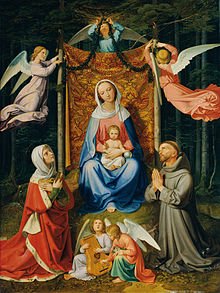Joseph von Führich

Joseph von Führich [or Josef Ritter von Führich] (February 9, 1800 – March 13, 1876) was an Austrian painter, one of the Nazarenes.
He was born at Kratzau (Czech: Chrastava) in Bohemia. Deeply impressed as a boy by rustic pictures adorning the wayside chapels of his native country, his first attempt at composition was a sketch of the Nativity for the festival of Christmas in his father’s house. He lived to see the day when, becoming celebrated as a composer of scriptural episodes, his sacred subjects were transferred in numberless repetitions to the roadside churches of the Austrian state, where peasants thus learnt to admire modern art reviving the models of earlier ages.[1]
Führich became a pupil at the Academy of Prague in 1816. His first inspiration was derived from the prints of Dürer and Peter von Cornelius’ illustrations to Goethe’s Faust, and the first fruit of this turn of study was the Genofeva series. In 1826 he went to Rome, where he added three frescoes to those executed by Cornelius and Overbeck[1] in the Casino Massimo, showing scenes from Torquato Tasso’s Gerusalemme liberata.[2]
Führich was an adherent of the Nazarene movement, a romantic religious artist who sought to restore the spirit of Dürer and give new shape to biblical subjects. Without the power of Peter von Cornelius or the grace of Johann Friedrich Overbeck, he composed with great skill, especially in outline. His mastery of distribution, form, movement and expression was considerable. In its peculiar way his drapery was perfectly cast.[1]
Austrian 10 Gulden note (1863) designed by Führich[3]
Essentially creative as a landscape draughtsman, he had no feeling for colour; and when he produced monumental pictures he was not nearly so successful as when designing subjects for woodcuts. Führich’s fame extended far beyond the Austrian capital, and his illustrations to Tieck’s Genofeva, the Lord’s Prayer, the Triumph of Christ, the Road to Bethlehem, the Succession of Christ according to Thomas a Kempis, the Prodigal Son, and the verses of the Psalter, became well known. His “Prodigal Son”, especially, is remarkable for the fancy with which the spirit of evil is embodied in a figure constantly recurring, and like that of Mephistopheles exhibiting temptation in a human yet demoniacal shape.[1]
